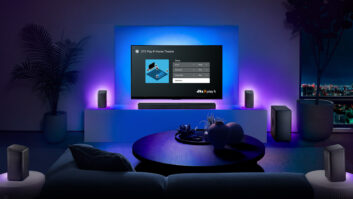Sources of discrete multichannel surround-sound for home theaters are proliferating and available in more homes than ever from a mix of new and legacy sources.
Sources include satellite TV, digital cable systems, terrestrial DTV stations, broadband-delivered video services, DVDs and high-definition Blu-ray discs.
As of mid-May, about 552 Blu-ray titles available in the United States sported multichannel sound in one or more formats, including uncompressed PCM, Dolby True HD and DTS HD Master, according to www.blu-raystats.com, a Web-based compiler of Blu-ray soundtrack data. Of those titles, 21 feature 7.1-channel soundtracks and 14 feature 6.1 channels.
All told, U.S. consumers bought about 5.6 million Blu-ray discs in 2007, accounting for $170 million in dollar sales, according to 20th Century Fox Home Entertainment estimates. The company also estimated that U.S. Blu-ray player sales hit about 3.7 million from launch through the end of 2007, including sales of Blu-ray-equipped PlayStation3 game consoles.
As for Blu-ray’s predecessor, the DVD, Consumer Electronics Association (CEA) consumer surveys found that 84 percent of U.S. homes owned at least one DVD player in January 2008, up from only 25 percent in January 2002. And these households had a choice of thousands of surround-sound-equipped DVD discs to play, according to Muze, which compiles databases of entertainment product information for retailers. By January 2007, the selection of U.S.-market DVDs encoded with 5.1 discrete surround-sound channels hit 16,576 out of 91,514 U.S. DVD titles, up from 940 5.1-channel DVDs in February 2000. Muze’s numbers include multiple versions of the same title: widescreen, full-screen, and special editions. Muze statistics for 2008 were unavailable.
A growing number of households are also getting access to discrete-multichannel soundtracks through their digital-cable operators. By the end of 2007, 37.3 million homes subscribed to digital cable, up from 32.6 million at the end of 2006, according to market researcher SNL Kagan. These households accounted for almost 29 percent of all 112.6 million TV-owning households and 57 percent of all 65.2 million cable subscribers. In contrast, only 9.7 million households subscribed to digital cable at the end of 2000, the National Cable and Telecommunications Association (NCTA) said.
Digital cable is poised to deliver surround sound to even more homes. A total of 116.8 million of the 123.4 million homes passed by a cable system are capable of getting digital service, SNL Kagan said. HD cable’s potential has similarly grown. By March 2007, 100 million households were passed by at least one cable system offering HDTV service, NCTA said. That represents all of the top 100 cable-TV markets and 209 of 210 cable markets.
Satellite-TV providers DirecTV and rival EchoStar are also doing their part to provide a surround-sound experience at home. EchoStar delivered 5.1 surround with select SDTV and HDTV programs to a combined subscriber base of 30.6 million homes at the end of 2007, up from 29.1 million at the end of 2006, according to SNL Kagan. Among those subscribers, the number of homes subscribing to satellite HD service rose to 4.5 million, up from year-end 2006’s 2.8 million, SNL Kagan said.
Households that don’t subscribe to either cable or satellite TV service can also enjoy 5.1-channel surround through a growing number of local over-the-air DTV stations, many of which deliver discrete 5.1-channel surround.
By January 2008, the overwhelming majority of local full-power commercial and public TV stations were broadcasting DTV signals in either SD or HD resolution, the National Association of Broadcasters (NAB) said. Out of 1,760 stations, 1,628 local TV stations in 210 markets made the transition to digital television, serving 99.95 percent of U.S. households, NAB said.
New sources are also delivering multichannel surround to homes, including the Internet-delivered on-demand Vudu service, Verizon’s fiber-optic FiOS TV service, and the planned XStreamHD service.












